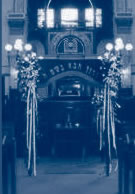|
SEDRA : NASO Hertz Chumash p. 586 Numbers
Chap. IV
This week's Sedra is generously sponsored by Martin Block.
SYNOPSIS:
Naso is the longest single Sedra in the Torah.
The Sedra takes up the theme of the duties of the Kohanim,
the sons of Gershon, Kehat and Merari. A census of the Kohanim
revealed the 8580 individuals aged between 30 and 50 years
were ready for service in the Sanctuary. All Israelites who
were Tameh (ritually impure) were then asked to depart the
encampment until they had undergone ritual purification.
Four laws involving Kohanim are then stated :
Where a person confessed to wrongfully retaining possession
of his neighbour's property, he was required to return this
plus a fifth of its value. A guilt offering was to be brought.
If the owner had died leaving no heirs, repayment was made
to the Kohen.
Where a husband suspected his wife of being unfaithful they
would go to the Kohen where a "Sotah" ceremony involving
the drinking of the "waters of bitterness" was undertaken.
If the wife had indeed been unfaithful, harmful effects would
ensue. Where the wife was innocent she was blessed with enhanced
fertility and motherhood.
The law of the Nazirite is described. A vow was taken by the
nazirite to completely consecrate himself to G-d for a given
length of time. During this period he was obliged to abstain
from strong drink of the fruit of the vine, let his hair grow
and avoid contact with a dead body. On the expiration of his
nazirite vow he brought a sacrifice and shaved his hair which
burned beneath the sacrifice. After the Kohen had performed
some additional ceremonies the Nazirite resumed his usual
lifestyle.
The Kohanim were directed to bless the people according to
a specific pattern set out in the Torah (and included in our
regular synagogue services).
The last section of the Sedra is called the "Nesiim".
Here each of the Princes and their gifts for the Sanctuary
in which the identical articles were presented on twelve successive
days, are individually recorded. A beautiful description of
Moses' entry into the Sanctuary on the day of its consecration
ensues. This is followed by an inventory of the gifts and
utensils for the Sanctuary.
HAPHTORAH HERTZ CHUMASH P. 602 Judges 13
The theme of the Nazirite which forms part of the Torah reading
finds its echo in the Haphtorah. Manoach and his wife are
visited by an angel who heralds the birth of a son Samson.
He is to be a Nazirite form birth and a saviour of his people.
The parents are given instructions as to the details of how
he should be raised to that calling.
TELL ME RABBI .....
IS THERE A BLESSING FOR THE CZAR? -
Yes, "May The Lord Bless And Keep The Czar ..... Far
Away From Us"(Fiddler)
PRAYER FOR THE WELFARE OF THE QUEEN
The custom of blessing the Head of State after the Reading
of the Torah is well founded in several Jewish sources. Avudraham
states: "After the completion of the Reading of the Torah
it is customary to bless the King and to pray to G-d to assist
him and grant him ascendancy over his enemies" as it
is written by the Prophet Jeremiah (Chap 29,7) "and seek
the peace of the city unto which I have exiled you, and pray
for her unto G-d, for in its peace you shall have peace".
We also find that in the Mishna (Pirke Avot, 3:2) it was stated:
"Rabbi Chanina the Deputy High Priest said: "Pray
for the welfare of the ruling power, since were it not that
they feared it, people would swallow each other alive".
When Simon the Just, Leader of the Jewish people, was confronted
by Alexander the Great he urged him not to destroy the Temple
in which prayers were regularly recited on behalf of the King.
(Yoma 69: Brachot 17). According to Sephardi custom the prayer
is also recited on Yom Kippur after Kol Nidre. The reason
it seems is lest it be alleged that since all vows have been
rescinded by the declaration of Kol Nidre, the oath of service
and allegiance to the King was also nullified. They therefore
immediately restate their allegiance to the Sovereign.
THE UNITY OF G-D ARISES FROM THE UNITY OF ISRAEL
"From what time may one recite the Shema in the morning?...
" (Others say) "From the time that one sees his
friend who is a distance of four cubits (away) and he recognises
him" (Talmud Berakoth 9b)
This dictum may be interpreted homiletically. When are you
spiritually qualified to recite the Shema and accept upon
yourself the yoke of the Heavenly Kingdom - to enter into
an intimate relationship with the Almighty ?
It is only when you are willing to recognise the religious
philosophy of one who is not in your daled ammoth - the "four
cubits" of your particular religious lifestyle i.e. who
has (within halacha), a slightly different approach (be it
chassidic or mithnagdic) and yet you accept the reality that
"no two minds are alike" (Bamidbar Rabbah 21:2),
and you do not try to fit everyone into your mould, then you
are spiritually eligible to recite the Shema and begin your
day in the good graces of the Almighty.
Rabbi Moshe of Kobrin in commenting on the verse, "From
amongst your brethren you shall take upon yourself a sovereign"
(Deut. 17:15), said, that this could also be read as, "Only
out of 'brotherhood' can you accept upon yourself the sovereignty
of G-d."
The key to being dutiful of G-d is unity with one another.
Part of the blessing which the Cohanim, the priests, bless
the Jewish people is "The L-rd shall make His face shine
upon you". (Numbers 6:25) One of the 613 commandments
is to Emulate the Almighty. What is the practical application
of this verse?
The great sage Shamai said, "Greet every man with a pleasant
expression of countenance". (Pirke Avos, 1:15) There
are three parts to this statement:
1. Countenance - The minimum is to turn your face towards
your fellow; don't greet anyone with side of your face. Turn
your full countenance towards him or her.
2. Expression - Your face must denote interest
3. Pleasant - Your countenance should also be pleasant. Since
G-d deals with us measure for measure, G-d makes His face
shine upon those whose faces shine to their fellow human being!
BACK TO SHABBAT SHALOM
TABLE
|








